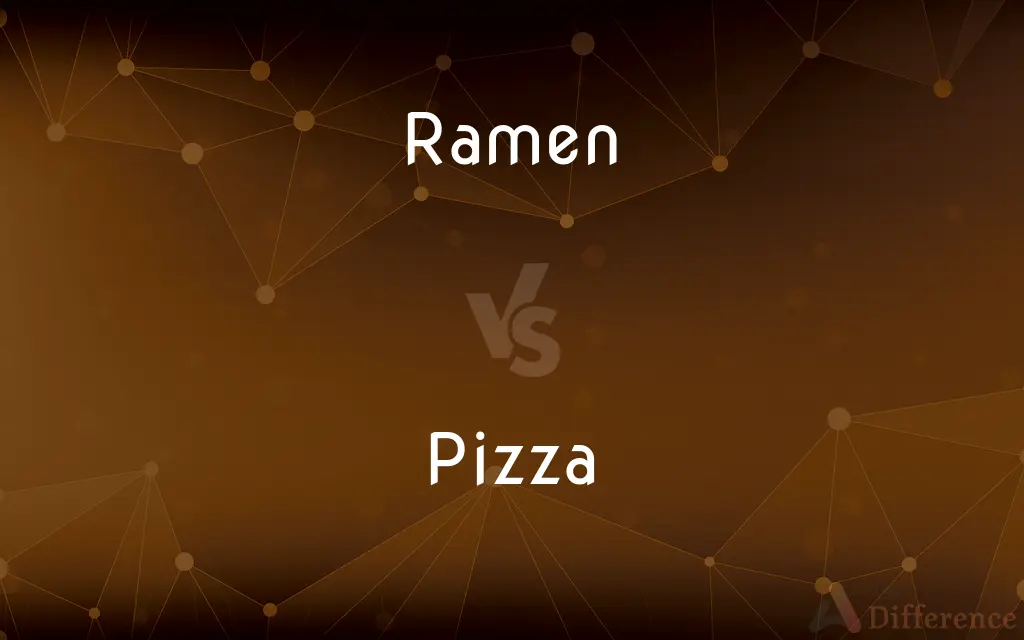Ramen vs. Pizza — What's the Difference?
By Fiza Rafique & Maham Liaqat — Updated on April 8, 2024
Ramen is a Japanese noodle soup, known for its rich broth and diverse toppings, while pizza is an Italian dish featuring a yeasted flatbread with various toppings.

Difference Between Ramen and Pizza
Table of Contents
ADVERTISEMENT
Key Differences
Ramen, originating from Japan, is celebrated for its complex and flavorful broth, combined with noodles, meat, and vegetables. It offers a vast array of variations, including shoyu (soy sauce), miso, and tonkotsu (pork bone broth) flavors. On the other hand, pizza hails from Italy and is beloved worldwide for its versatility in toppings and styles, such as Margherita, pepperoni, and Hawaiian, on a yeasted flatbread base.
While ramen is often consumed as a warm, comforting meal, especially favored in colder weather due to its hot broth, pizza is enjoyed in both hot and cold settings, making it a popular choice for gatherings and quick meals. Whereas ramen's essence lies in the balance and depth of its broth, which can take hours to prepare, the charm of pizza is in its crispy crust and the interplay of toppings and melted cheese, with preparations ranging from quick baking to intricate dough fermentations.
Ramen typically emphasizes the harmony of flavors in its broth and the quality of its noodles, with a focus on the culinary craftsmanship in creating a balanced dish. Pizza, however, offers a canvas for creativity, allowing for a wide range of ingredients from simple tomato and cheese to gourmet combinations, reflecting local tastes and preferences worldwide.
The experience of eating ramen is often associated with sit-down meals in noodle houses, where the dish is served piping hot and consumed quickly to enjoy the noodles at their best texture. In contrast, pizza is versatile in its consumption, suitable for dine-in, takeout, or delivery, and is a staple of casual dining and social gatherings.
Comparison Chart
Origin
Japan
Italy
ADVERTISEMENT
Base
Wheat noodles
Yeasted flatbread
Key Components
Broth, noodles, meat, and vegetables
Tomato sauce, cheese, and various toppings
Cooking Time
Broth can take hours to prepare
Varies, but typically quick baking
Serving Temperature
Typically hot
Can be enjoyed hot or cold
Varieties
Shoyu, miso, tonkotsu, among others
Margherita, pepperoni, Hawaiian, among others
Cultural Significance
Symbol of comfort food in Japanese cuisine
Emblematic of Italian cuisine, popular worldwide
Compare with Definitions
Ramen
A Japanese noodle soup dish.
Ramen is served with a variety of toppings, including pork slices, green onions, and boiled eggs.
Pizza
An Italian dish consisting of a yeasted flatbread.
Pizza dough is topped with tomato sauce and cheese, then baked.
Ramen
Known for its rich, flavorful broth.
The broth of ramen can be soy sauce, miso, or pork bone-based.
Pizza
Features a variety of toppings.
Pizza toppings can range from vegetables to meats and even fruit, like pineapple.
Ramen
Served hot and eaten with chopsticks.
Ramen is best enjoyed hot, immediately after it's served to appreciate its flavors.
Pizza
Can be baked in various types of ovens.
Wood-fired pizzas have a distinctive smoky flavor.
Ramen
Often garnished with nori, bamboo shoots, and sprouts.
A slice of naruto, with its pink swirl, is a common garnish in ramen.
Pizza
Styles include Neapolitan, Chicago deep-dish, and New York thin crust.
Chicago deep-dish pizza is known for its thick crust that supports a heavy load of toppings.
Ramen
Varieties include shoyu, miso, and tonkotsu.
Tonkotsu ramen has a creamy pork bone broth.
Pizza
Served sliced and often eaten with hands.
Pizza is a popular party food, easy to share and eat without utensils.
Ramen
Ramen () (拉麺, ラーメン, rāmen, Japanese pronunciation: [ɾaꜜːmeɴ]) (literally: "pulled noodles") is a Japanese noodle soup. It consists of Chinese-style wheat noodles served in a meat or (occasionally) fish-based broth, often flavored with soy sauce or miso, and uses toppings such as sliced pork (叉焼, chāshū), nori (dried seaweed), menma, and scallions.
Pizza
Pizza (Italian: [ˈpittsa], Neapolitan: [ˈpittsə]) is an Italian dish consisting of a usually round, flattened base of leavened wheat-based dough topped with tomatoes, cheese, and often various other ingredients (such as anchovies, mushrooms, onions, olives, pineapple, meat, etc.), which is then baked at a high temperature, traditionally in a wood-fired oven. A small pizza is sometimes called a pizzetta.
Ramen
(in Japanese cuisine) quick-cooking noodles, typically served in a broth with meat and vegetables.
Pizza
A baked pie of Italian origin consisting of a shallow breadlike crust covered with toppings such as seasoned tomato sauce, cheese, or sausage.
Ramen
A Japanese dish of noodles in broth, often garnished with small pieces of meat and vegetables.
Pizza
(uncountable) A baked Italian dish of a thinly rolled bread dough crust typically topped before baking with tomato sauce, cheese, and other ingredients such as meat, vegetables or fruit
A slice of pizza
A pizza pie
Want to go out for pizza tonight?
Ramen
A thin white noodle served in this dish.
Pizza
(countable) A single instance of this dish
He ate a whole pizza!
Should we cook a frozen pizza for dinner?
Ramen
Soup noodles of wheat, with various ingredients (Japanese style)
Pizza
Italian open pie made of thin bread dough spread with a spiced mixture of e.g. tomato sauce and cheese
Ramen
A type of instant noodles.
Ramen
Amen
Common Curiosities
Can ramen be considered fast food?
While ramen can be served quickly, its preparation, especially the broth, is often elaborate and time-consuming.
What is ramen?
Ramen is a Japanese noodle soup with a broth typically flavored with soy sauce or miso, served with various toppings.
How is ramen traditionally eaten?
Traditionally, ramen is eaten with chopsticks, and the broth is sipped directly from the bowl.
What's the difference between shoyu and miso ramen?
Shoyu ramen is soy sauce-based with a clear, brown broth, while miso ramen features a thicker, richer broth made with miso paste.
What is pizza?
Pizza is an Italian dish featuring a yeasted flatbread base, topped with tomato sauce, cheese, and other ingredients, then baked.
Are there gluten-free pizza options?
Yes, many pizzerias and recipes offer gluten-free crust options made from alternative flours.
What's the origin of pizza?
Pizza has its origins in Italy, specifically Naples, and has evolved into various styles across the world.
What are the common toppings on pizza?
Common pizza toppings include mozzarella cheese, tomatoes, pepperoni, onions, and olives.
Is pizza considered healthy?
Pizza can vary in healthiness based on its ingredients; whole-grain crusts and vegetable toppings offer more nutritional benefits.
What makes ramen broth unique?
Ramen broth is unique for its depth of flavor, often achieved through simmering meat, fish, and vegetables for several hours.
Can ramen toppings vary?
Yes, ramen toppings are highly variable and can include meats, vegetables, eggs, and seaweeds.
How is pizza dough made?
Pizza dough is made from flour, water, yeast, and salt, kneaded together and left to rise before baking.
Is ramen eaten year-round?
Yes, ramen is enjoyed year-round, though it may be particularly comforting during colder months.
How many calories are in a slice of pizza?
Calories in pizza can vary widely depending on the toppings and crust, ranging from 200 to over 400 calories per slice.
What's the best way to reheat pizza?
Reheating pizza in an oven or toaster oven is preferred to maintain its crispy crust.
Share Your Discovery

Previous Comparison
Blet vs. Bled
Next Comparison
Accidentally vs. DeliberatelyAuthor Spotlight
Written by
Fiza RafiqueFiza Rafique is a skilled content writer at AskDifference.com, where she meticulously refines and enhances written pieces. Drawing from her vast editorial expertise, Fiza ensures clarity, accuracy, and precision in every article. Passionate about language, she continually seeks to elevate the quality of content for readers worldwide.
Co-written by
Maham Liaqat













































